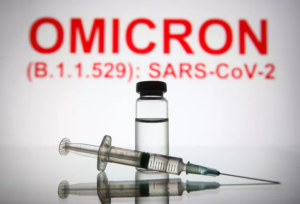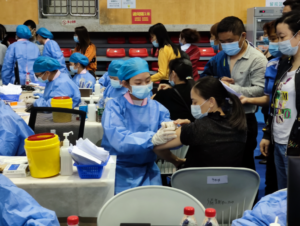
A large number of testing organizations will be in financial crisis after the termination of routine nucleic acid testing
On the day the regular nucleic acid testing sites in Guangzhou were removed, a sanitation aunt was still accustomed to riding her bicycle before and to her familiar nucleic acid site, and waiting for her were many people as bewildered as she was, and staff shouting, “No more nucleic acid in the future.”
In the past three years, the number of nucleic acid testing sites has gradually increased to the point where they are more common than public toilets. Behind the demand for nucleic acid testing, listed companies in the nucleic acid testing business have disclosed revenues of billions of dollars, and many companies have successfully IPO’d.
But when everything suddenly ended, the whole nucleic acid testing industry seemed to leave only a “chicken feather” behind what outsiders thought was a huge profit. An investment banker told the interface news reporter, although the consensus in society is that the nucleic acid testing concept companies earn a “pot full of money” in the past three years. But the industry has a contrary consensus. In fact, the performance of nucleic acid testing companies, especially the high amount of accounts receivable problems, will be concentrated in 2023.
An explosion in a cold industry
The need for new crown nucleic acid testing was born overnight. It started with a simple vision – find every virus.
At the beginning of 2020, it was not easy to get a nucleic acid test – a person could only get a nucleic acid test if they had symptoms such as a fever and went to a fever clinic. Due to a lack of supply, nucleic acid testing was once an initial “problem” for Wuhan’s outbreak prevention and control.
But by the summer of 2021, nucleic acid testing had penetrated people’s lives. From mass testing to regular full-scale testing to a “15-minute nucleic acid circle”. But there is a vague sense of this infiltration, which has suddenly appeared in life and rightfully become part of it.
According to the national nucleic acid testing information platform, as of May 11, 2022, there were 13,000 health care institutions and 153,000 technicians providing nucleic acid testing services for the new coronavirus, with a total testing capacity of nearly 57 million tubes per day.
Nucleic acid testing belongs to the in vitro diagnostic (IVD) industry, which can be divided into biochemical, immunological and molecular diagnostics. Nucleic acid testing belongs to one of the molecular diagnostic technologies. In fact, before the epidemic, molecular diagnostics was a complicated and little existed technology.
“Before the outbreak of the new crown epidemic, the industry basically thought that molecular diagnosis was a technology that was too costly and difficult to promote, and for a long time it was in a state where it was not profitable, and it did not know where its prospects were.” A person from a primary market investment company told the interface news reporter.
But after the sudden outbreak of the new crown epidemic, molecular diagnosis ushered in unprecedented application development opportunities. With the increasing demand for “all tests should be tested”, the upstream and downstream markets of the whole industry have grown significantly.

Figure
The upstream of the nucleic acid testing industry chain mainly includes antigens, antibodies, enzymes and coenzymes, polymer plastic consumables manufacturers and diagnostic instruments manufacturers; the midstream includes sample collection and preservation reagent manufacturers, nucleic acid extraction reagent manufacturers and reagent manufacturers; the downstream includes hospital terminals, third-party testing institutions, third-party laboratories, etc. Among them, the upstream reagents raw materials and testing equipment are still dominated by overseas giants such as Roche, Siemens, Abbott, Illumina, etc. The domestic camp only has a few enterprises such as Novozymes, Fipen Bio, UWI. Domestic nucleic acid testing companies are still mainly focused on midstream reagent production and downstream testing.
According to the A-share listed companies in the third quarter of 2022 financial report. 67 nucleic acid detection probable companies achieved a total revenue of 251.6 billion yuan, net profit of 72.8 billion yuan.
Among them, Dean Diagnostics and Goldfield Medical represent the status quo of third-party laboratories of offline sampling and testing institutions. 2019 to the first three quarters of 2022, Dean Diagnostics achieved revenue of 8.453 billion yuan, 10.649 billion yuan, 13.082 billion yuan and 15.629 billion yuan, respectively; net profits of 347 million yuan, 803 million yuan, 1.163 billion yuan and 2.428 The net profit was RMB 347 million, RMB 803 million, RMB 1.163 billion and RMB 2.428 billion respectively. During the same period, Goldfield Medical achieved revenue of 5.269 billion yuan, 8.244 billion yuan, 11.943 billion yuan and 12.208 billion yuan, respectively; and net profit of 402 million yuan, 1.510 billion yuan, 2.220 billion yuan and 2.448 billion yuan, respectively.
It can be seen that, although nucleic acid testing has greatly enhanced the revenue of sampling and testing institutions, but the actual profit is not high.
Compared to sampling testing, midstream reagent manufacturers are clearly more profitable. For example, from 2019 to the first three quarters of 2022, Minebio realized revenue of 181 million yuan, 959 million yuan, 2.83 billion yuan and 7.470 billion yuan, respectively; and realized net profit of 41.558 million yuan, 469 million yuan, 1.413 billion yuan and 3.838 billion yuan, respectively. Wanfu Bio achieved revenue of 2.072 billion yuan, 2.810 billion yuan, 3.361 billion yuan and 4.696 billion yuan, respectively; and net profit of 387 million yuan, 634 million yuan, 634 million yuan and 1.240 billion yuan, respectively. Kepo Bio achieved revenue of 729 million yuan, 1.354 billion yuan, 2.673 billion yuan and 4.259 billion yuan respectively; net profit was 147 million yuan, 363 million yuan, 852 million yuan and 1.488 billion yuan respectively.
Among them, Daan Gene is one of the few companies involved in upstream equipment, midstream reagents and downstream testing at the same time. 2019 to 2022 first three quarters, Daan Gene achieved revenue of 1.098 billion yuan, 5.341 billion yuan, 7.664 billion yuan and 9.335 billion yuan, respectively; achieved net profit of 92.181 million yuan, 2.449 billion yuan, 3.618 billion yuan and 4.911 billion yuan.
Testing organizations that do not receive money
But with the abrupt end of normalized nucleic acid testing, around have announced “non-essential not nucleic acid”, an investment banker analysis that some nucleic acid testing companies will be overloaded in 2022 and the first two years of money earned are lost back.
She believes that, from the perspective of the secondary market, the performance growth gives the nucleic acid testing concept companies the opportunity to speculate on the stock price. Antibodies, enzymes and coenzymes, polymer plastic consumables manufacturers and diagnostic instruments and sample collection and preservation reagents, nucleic acid extraction reagents and reagent production and other midstream manufacturers did make money, but the third-party testing laboratories located in the downstream may not be so good days.
For example, the industry’s upstream main nucleic acid reagent raw materials of Fipen Bio, 2019 to 2021, the main business gross margin of 92.81%, 94.02%, 88.43%; midstream companies, Daan Gene in 2021 sales of new crown nucleic acid test kits gross margin is also still up to 88%; but in the downstream companies, Goldfield Medical 2021 gross margin of third-party medical diagnostic services is only 47.2%.
In fact, nucleic acid testing is an unprofitable and laborious business for some of the third-party testing labs located downstream. In fact, the profitability of downstream is directly proportional to the volume of business scale. Because the new crown test reagents in the domestic has long been included in the collection, profit margins are extremely limited, only the industry’s leading enterprises have the ability to make money.
The aforementioned investment bankers analysis, many do nucleic acid testing of third-party testing laboratories enterprise threshold is not high, as long as you can get the qualification to operate, but the testing volume is difficult to break through, can not form a scale effect to make money.
More importantly, even large-scale third-party testing laboratory companies in the industry are now facing the risk of excessive growth in accounts receivable, which may suffer large impairment charges. A shares, for example, several third-party testing laboratories listed on the proportion of accounts receivable have seen a super substantial increase.

Data Chart
As of the first three quarters of 2021, Goldfield Medical achieved revenue of 12.208 billion yuan, of which accounts receivable was 7.433 billion yuan, accounting for 60.89% of operating revenue, an increase of 66.65% year-on-year; Dean Diagnostics achieved revenue of 15.63 billion yuan, of which accounts receivable was 10.754 billion yuan, accounting for 68.8% of operating revenue, an increase of 76.75% year-on-year.
In contrast, the middle and upper reaches of the enterprise is basically no pressure to pay back, often the accounts to the middle and upper reaches of the enterprise before shipping to the downstream.
Under pressure to pay back, nucleic acid testing companies have already gone to court with their service purchasers. The civil ruling announced by the Beijing High People’s Court on November 29 shows that Beijing Main Medical Testing Laboratory Co., Ltd. sued the People’s Government of Yongding Town, Mentougou District, Beijing and the Beijing Mentougou District Maternal and Child Health Hospital, demanding that the other party should pay the testing fees to Main in accordance with the standard price of 180 yuan per person.
The volume of smaller nucleic acid testing kiosks have also begun to transfer at low prices, from Baidu love procurement, idle fish and other platforms found that some nucleic acid kiosk business even hit three to five thousand yuan, or even a few hundred yuan “floor price” resale.
A number of listed companies in the nucleic acid testing concept said that now not only face the problem of declining prices, but also face the risk of business shrinkage, will return to the normalization of business before the epidemic.
As Lanwei Medical said in this regard: “The business will not have a big impact, the company is doing very well in the other testing business of the epidemic, and will strengthen the business in addition to this piece of nucleic acid testing.” Daan gene in an interview with the surging news, said, “this year (2022) business will not be affected, the impact of this until next year, but also to see the specific policy adjustments.” The company said, “Nucleic acid testing is not the direction of our development, business will return to the state before the epidemic, this year (2022) has begun to adjust, like the expansion of overseas business and so on.”
In fact, some companies have also started to plan their retreat. in November 2022, Daan Gene reduced the price of several testing reagents by nearly 70%, opening a price war in the market in the post-New Crown era, while Shengxiang Biologicals made a series of acquisitions to expand its business in several directions.


Average Rating